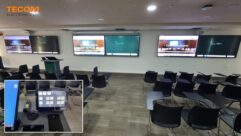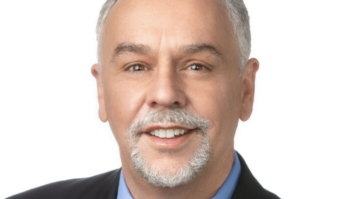Philip Hagood, General Manager at InteRise and Brent Dye, audio engineer at Grace Polaris Church, finish their story on the extensive video, sound and lighting upgrade finished at the church just before the global shutdown. During the project, resources were freed up and more extensive video streaming capability was installed. This turned out to be a real stroke of luck when the pandemic hit.
Images by Grace Polaris Church
When Grace Polaris Church built their new worship space no one thought about facing a global pandemic. With help from integration firm InteRise, the church had found a way to have better video streaming ability and now they’re very glad they did. Philip Hagood of InteRise and Brent Dye of Grace Polaris Church finish their story on it, coming up on the SVC Podcast.
Phil and Brent, good to have you back for Part 2, Phil coming to us from Nashville and Brent in Columbus, Ohio at Grace Polaris Church. Big renovation at the church and good things happening on the video side that have you streaming your services at a time when that’s the only possible connection for the congregation. Brent, you’re in the church so how large a production crew do you have for streaming the services?
Brent: For the time being, because we are working with a skeleton crew, I believe there are four people in the video production booth and two people in the auditorium on manned cameras. For the audio side there is one person in video production who is doing the broadcast mix and then I am out at FOH doing the house mix. [Timestamp: 1:22]
OK so not too many people to keep up with but with the current situation every extra crew member is a potential hazard. They’ve got to be essential.
Brent: That’s right.
Phil, when the project started, you put in the Sony HXC-FB80 cameras and the Ross PivotCams. Was that decision driven by cost or features?
Philip: Yeah. Like with so many things a combination of both. The way the project started out we wanted to look at the ability to have infrastructure for four manned cameras inside the room but also have the ability to add additional cameras in the lobby or ancillary spaces for any kind of remote connectivity in the future. So as the project sent through value engineering and as we adjusted the budget we actually ended up changing back to a PTZ-focused system, the Ross PivotCams. Leaving the infrastructure for the manned cameras but just that way there would be camera shots to take day one but there wasn’t a lot of resources put into manned cameras. As the project went on, as we talked about in Part 1, through some cost savings they were able to expand into two of the four Sony FB80 cameras as well as three or four PivotCams around the space to pick up some ancillary shots. So honestly the feature set of both of those cameras and the way that they work together inside of the switcher is really great and something that for InteRise has been a really effective combo. The PivotCams allow direct integration with the Ross switcher and Dashboard Control, which is software that Ross makes to operate a lot of their products together in a unified kind of IP-based platform. And then the Sony cameras, it’s a fantastic camera. It’s a relatively new product for Sony here in the last few years so it provides a really great 1080 image. It allows us to have that Sony kind of quality look. Sony is synonymous in the broadcast world for the look and the quality of the camera and you definitely get that, even at a more entry-level price point, in the FB80. That’s really the fantastic part of the FB80 inside of this project for Grace Polaris is you’re able to get a lot of the feature set of the $100,000.00 camera and not have to spend $100,000.00 to buy into that higher tier broadcast camera platform. So it’s really been great. And then we’ve been able to make these cameras look really good together because the carbonite switcher that’s the central hub of the whole video system has color correctors and some of those other things built into it as part of the software that allow us to tweak and paint the cameras in the CCU’s, in the RCP’s, in the cameras themselves. But then also on the switcher side make some final adjustments to be able to really make sure that you have consistent image as you cut through the cameras. So it’s really exciting how they’ve all kind of worked together and it gives them six or eight angles to be able to cut through as they do video production both in remote broadcast right now and then once they have people back in the room. . [Timestamp: 4:24]
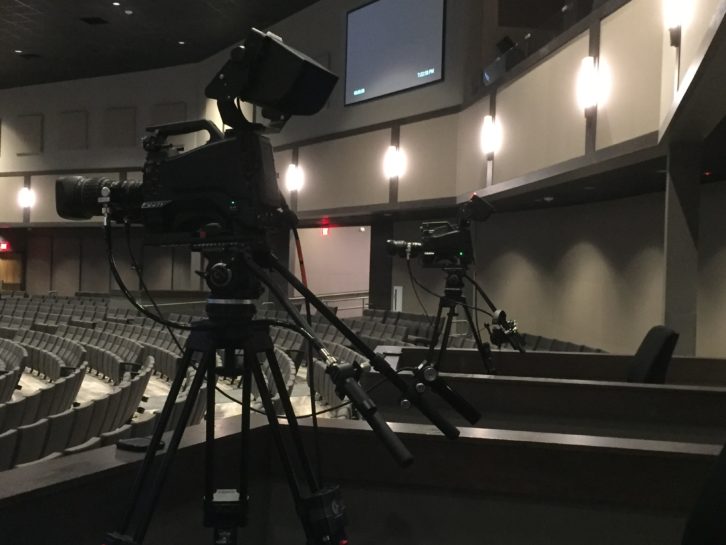
On the lighting, the cameras tend to see things a little differently than the human eye. Brent, how do you handle the lighting in there? Is it set up just for the cameras since there’s no in-person congregation or is it still just set up the way you originally had it?
Brent: It’s everything is on, basically. The house lights and the stage lighting, it’s just more or less all on. There is some backlighting and accent lighting that’s been done. I’m not sure that all of the lighting programming was finished and so we were just kind of trying to figure out what we could do just to get things on and get things working enough to get us through these video shoots. So yeah, the answer everything is pretty much just full on so we can get the light that we need and just a little splash of color here and there. . [Timestamp: 5:20]
And in addition to the lighting you have to get audio and video signals around the place so Phil, how did you set up with AV network?
Philip: So there’s a couple of different protocols we’re working with. Most of our designs are focused on a concept of simplicity but robustness. It’s really easy for all of us that are technical people, that are engineers, to come up with these really intricate systems and really intricate ways of man, I can have this one piece of gear and it does 45 things. I would rather have one piece of gear that does one or two things really, really well. So that’s kind of the backbone that we took so we have a lot of interconnection between these systems that allow you to get a lot of different things around the facility but focusing on video distribution via SDI around the facility. So both inside the room with just basic connectivity to cameras and displays and then also outside the room to ancillary rooms, cry rooms, choir rooms, the lobby, things like that, it’s all SDI distribution with audio embedded on the SDI. On the actual audio side the system is driven by a QSC Q-SYS processor. So Q-SYS has a Q-LAN protocol that allows us to also push audio around the facility by IP but honestly we’re relying more on the Dante side that’s connected directly to the console system, as Brent talked about in Part 1, with Ableton and some of those connectivity pieces where we have a lot of CAT5, CAT6 infrastructure around the facility to push audio around via Dante, via IP. And then lastly on the lighting side, we’re using streaming ACM through Pathway. Pathway is a manufacturer that makes a lot of different lighting infrastructure components. So that also allows distribution by IP. So basically as long as we have fiber and CAT and network switches in the places that we need them we can get virtually anything audio, video lighting related connected, controlled in those different locations, but we also keep it separated enough where the number of failure points we have are broad. So if, God forbid, something were to fail we don’t take down the entire building, the entire system, because we put everything on one protocol. We still keep it separated enough so that it’s easy and flexible but also really robust. . [Timestamp: 7:46]
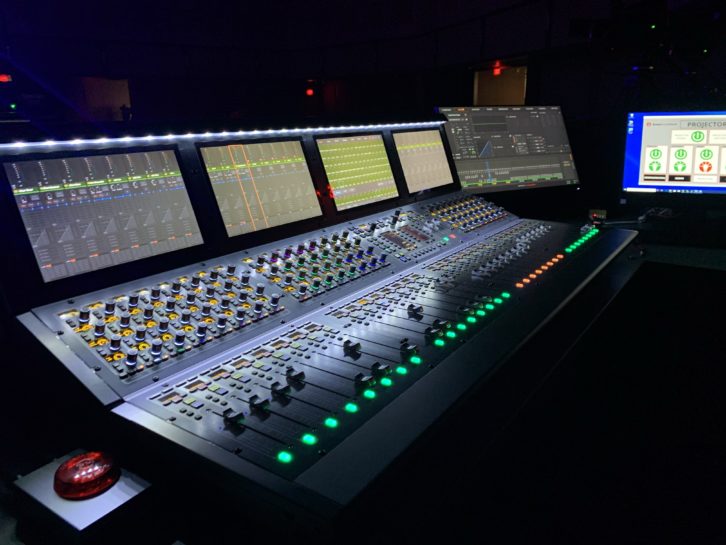
I’m sure there’s some initial tweaking so that everything can run pretty much on auto pilot for the network. Brent, we’ve talked about how you do the services. Are there other events that are streamed in there as well or do you just concentrate on the two services for Sunday?
Brent: In the past we haven’t really done any streaming just because of the low quality, the cameras that we had. So this is really sort of new territory for us and so far we’re very pleased with the results that we’re getting. And we look forward – in the future we look forward to doing some more. . [Timestamp: 8:21]
Does it appear to you that the younger members of the congregation tend to take to the streaming more than the traditional members? How has the reaction from the congregation been to this?
Brent: You know, I don’t have the hard numbers in front of me but I had heard the first week we had quite a few people that had tuned into the stream. And we’ve tried to make it ask simple as possible for everybody by sending out an email with a link to the video so all they have to do is click on the link in the video, or in the email, and it will take them right to the video that’s online. So we’ve had a lot of people that some are watching on their phones, others on their iPads, some on their computers and there are some that will stream it to their TV. So everybody is getting involved. I know several of the older folks are more comfortable with the computer. My parents are sitting there watching it on the computer, so yeah it seems to be working out for everybody. . [Timestamp: 9:24]
I’m sure you’ve got plans in place for when you get everybody back in the church and how to do it safely. People will want to hug and shake hands and that could be a little dicey so how are you going to handle it when you get people back in there?
Brent: Well, that’s something that’s being discussed at the moment because we’re not exactly sure how soon we will actually be allowed to open up. There are some talks of some different ideas, different things that we might try before we actually open the building up for a service but yeah, it’s an interesting time and it will be interesting to see how things flow and how soon we can get everybody back together again. . [Timestamp: 10:04]
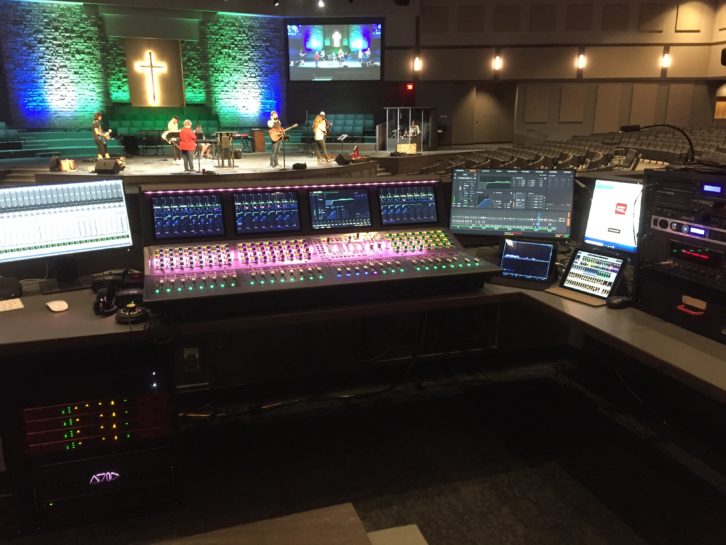
Churches will be watching each other to see what ideas there are. Both installation and production will be facing some creative challenges. Great having you both here to talk about this. Lots of questions up in the air right now. We’re talking to Philip Hagood, General Manager with InteRise in Nashville and audio engineer Brent Dye with Grace Polaris Church in Columbus, Ohio. New video streaming ability just in time for a global pandemic. Congratulations to you both on a great job in a weird situation we have. Thanks for being with us.
Brent: Thank you very much for having us.
Philip: Yeah, thank you. We’re really grateful to be featured and really grateful for the partnership with Grace Polaris. So thanks for the time today.
Grace Polaris Church is well set up to keep in touch with their congregation during a very challenging time. Thanks to InteRise in guiding the choices they made to get there. Get with us for another show on how the AV industry and those in it are dealing with this very special time, all on the next SVC Podcast.




